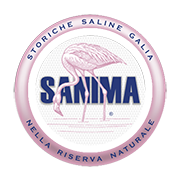Galia Saltpan is part of Saltpans Reserve of Trapani
SA.NI.MA. Sale di Trapani Ancient Galia Saltpans
Along The Salt Road from Trapani to Marsala, you can discover one of the most evocative places of our territory, the Saltpans.
The wide ponds are full of sea water, changing their colour according to the season. Here, from August onward, salt workers collect the sea salt. The ponds and the channels extend as far as the sea; ancient windmills rise among the bright white salt hills.
WWF has managed The Riserva Naturale Orientata Saline di Trapani e Paceco, since 1995; it is over 1,000 hectares wide and also includes Salina Galia.
The preservation of this extraordinary habitat allows a lot of animals and plants to survive. You can still cultivate and harvest your sea salt and grant for its pureness, thanks to naturally healthy environment.
Saltpans are the wonderful result of a link between nature and human labour, going back to Phoenicians' stay in this part of Sicily.


They were skillful merchants, and found in the low, warm and windy Trapani coastline the ideal place for producing salt.
The Saltpans have great ornithological importance, as the perfect place for water birds to rest, since many species stop here during their migrations.
During spring and autumn flamingoes, herons, egrets, spoonbills, marsh harriers, ducks, avocets, stilts, terns, plovers, slender-billed gulls, kingfishers (among the others) can be seen flying, feeding and resting everywhere.
As for the flora, In spite of the strongly brackish habitat, many plants thrive here: the precious sea marigold, the rare Malta fungus (a parasyte), and also Salicornia, Halocnemum, Arthrocnemum, Halimione.
Last but not least, the small Artemia Salina, a crustacean that is very interesting for biologists and zoologists.
We can finally conclude that the Saltpans world – although artificial- has a key role in keeping and safeguarding biodiversity.
SA.NI.MA. Sale di Trapani - FOOD PRODUCTS
